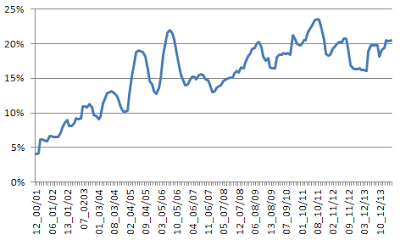TFL aren't publishing the actual number of bike journeys (as presumably there is no way to easily measure all bike movements) but have released indexed figures on a monthly basis. When I say monthly, It would be more appropriate to say on a four week basis, as TfL like for each reporting period to have the same number of days, so they have 13 reporting periods.
Looking at the data, it's clear that cycling is increasingly popular. The chart below shows the relative increase in cycling (ignore the scale, it's meaningless) for every year since 2000/01, with the number of bicycle journeys annually about two and a half times higher in 2012/13 than in 2000/01 - clearly a decent rate of growth.
Similarly, looking just at "period 1" (April 1-28) for each year we can see a steady upward trend - for year-on-year comparisons of individual "periods" there are blips, but its likely that weather affects matters.
However, if we plot the relative number of journeys in every 4 weeks "period", we can see there is significant seasonal fluctuation. What'ts more striking for me is that the variation appears to also be growing over time (if we look at the range between each peak and subsequent trough).
I applied a seasonal adjustment to try and iron out this level of variation to try and get a better idea of what the trend was and this is shown by the red line in the chart below. However, by applying this adjustment, I've actually increased the level of variation in earlier periods, as the adjustment appears to overcompensate. The two black lines on the chart are the trends for period 8 (October) - what I'm thinking of as the end of temperate weather and period 10 (mid December-mid Jan) which I think is a good marker for height of winter (shortest days, cold, wet etc).
Looking at the two trend lines and the datapoints, we can see very divergent trends for the numbers of journeys in these periods, which emphasises the very seasonal uptake in cycling - whereas in the past the number of journeys each month was relatively steady, the real profliferation in cycling has been in warmer months. Basically, London has a large population of fair weather cyclists who don't appear to like to stick it out in the cold, dark and wet months.
Now, clearly as the number of journeys increases, we would expect the absolute diference in the number of journeys in winter and summer to increase, but not necessarily the relative difference. Whilst summer cycle journeys have nearly tripled, our 'winter' journeys have increased by about 50% - not an unimpressive figure, but if we want a year round modal shift in journeys, work needs to be done. In the TfL data there are some comments about weather and 'coldest January ever' etc, but it's difficult to consider these statistically. I am looking for some decent London weather data.
To consider this high variability period-on-period, I have calculated a 13 period rolling co-efficient of variation for the preceding 13 periods- basically the ratio of the standard deviation compared to the mean. Because the co-efficient it is 'dimensionless' when looking at trends, we don't need to worry about the fact that an increase in journeys would most likely lead to an incrase in variance/standard deviation. We can see that the level of variation has definitely increased over the period. Interestingly though, the largest spikes in variation were in 2004 and 2005 and I don't know what drove this.
 |
| Co-efficient of variation (rolling, previous 13 periods) |
What is particularly interesting is there are no sizeable increases that match particularly well to issues like the 7/7 bombings, opening of cycle super highways or even Boris Bikes - there is jus ongoing increase. I have another dataset on Boris Bike usage, and I'll be looking at this in greater depth.
So, in conclusion the data shows more journeys are being made by bike in London, but a large number of new cyclists don't don lyrcra with equal frequency through the year.
So, in conclusion the data shows more journeys are being made by bike in London, but a large number of new cyclists don't don lyrcra with equal frequency through the year.










